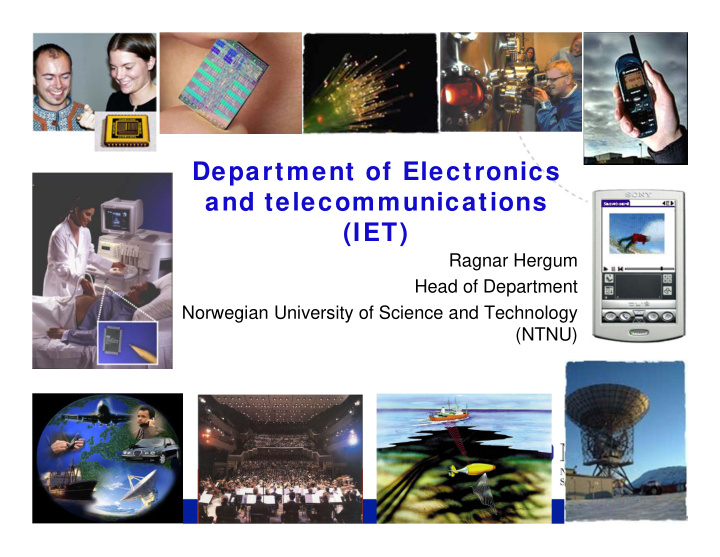



1 Department of Electronics and telecommunications (IET) Ragnar Hergum Head of Department Norwegian University of Science and Technology (NTNU)
2 NTNU organization BOARD INFORMATION DIV. TECHNICAL DIV. FINANCIAL DIV. STUDENT & ACAD. DIV. RECTOR ORGANIZATIONAL DIV. UNIVERSITY LIBRARY MUS. NAT.HIST. & ARCHEOL. FACULTIES INFORM. TECH., SOCIAL ARCHITECTURE ENGINEERING NATURAL ARTS MATHEMATICS MEDICINE SCIENCES & & FINE ART SCI. & TECHN. SCI . & TECHN . & ELECTR. ENG. TECHN. MAN. Departments Dep. of Electronics & telecommunications (IET)
3 Department of electronics and telecommunications (IET) Academic staff: Key figures (average): • Professors 25 • MSc graduates 60-80 • Associate professors 10 • PhD graduates 12-15 • Adjunct professors 7 • Post.doc / researcher 24 • R&D projects (external) 60 • PhD-students (100) 60 • Annual budget € 6 mill • Project budget (ext) € 5 mill • Techn./adm. staff 20
4 Department of Electronics and Telecommunications (IET) Scientific groups Electronic Signal Radio Circuits and Electro- Acoustics Devices and processing Systems Systems optics Materials Research: • Micro- og nanotechnology • Wireless and wired communication • Sensor technology • Marin acoustics/under water comm. Innovation and Creativity • Medical technology • Multimedia-, speech- and signal processing
5 VISION The Department of Electronics and Telecommunications (IET) shall within its academic disciplines be the leading academic research- and education centre in Norway. Within selected areas the department has the ambition to be on an international leading level. TASK IET shall perform NTNU ´ s activity within electronics and telecommunication.
6 Research at the Department of Electronics and Telecommunications
7 Research areas We believe the future development for our department to be within the following topics: Micro- and nanotechnology Sensor technology Medical technology Wireless and wired communication Marin acoustics and under water communication Signal processing
8 Electronics Master Programme Nanoelectronics and photonics Design of Digital Systems Circuit and Electronics System Design Analog Circuit Design and Radio Engineering Communication Systems Signal Processing and Communication Signal Processing, Acoustics and Media 1st and 2nd year 3rd year 4th and 5th year
9 Study Programmes Nanotechnology Nano- electronics and photonics Electronics Embedded Communication Computer Systems Technology
10 The Acoustics Group Research activities cover four main areas Communication acoustics Environmental acoustics Underwater acoustics Technical acoustics Close cooperation with SINTEF through the so- called Gemini centre “Acoustics Research Centre”.
11 The Signal Processing Group The main academic research activities cover Signal processing Statistical signal theory Information and communication theory Focus areas: telecommunications speech technology multimedia wireless sensor technology medical technology
12 The Radio Systems Group Core competence in radio and wireless sytems. Research activities within Antenna analysis and design Navigation systems High frequency circuit design and measurement techniques Microwave chemistry
13 The Circuit and Systems Group Field of experience covers microelectronics design and test. In particular activity within VLSI digital signal processing HW/SW co-design Design of test methodology Low-power digital design Analog and mixed signal design System-on-a-chip design methodology Device modeling
14 The Electronic Devices and Materials group Research activities: The oxide electronics lab Mid-infrared semiconductor lasers SAW devices Compound semiconductor surface studies Semiconductor device modeling and simulation Nanophotonics
15 The Electrooptics group The research areas include Biomedical optics Nanophotonics and photonic components Quantum cryptography
16
Recommend
More recommend